Neurofibromatosis
What is Neurofibromatosis?
Neurofibromatosis is a genetic disorder that mainly affects nerves, other parts of the body also gets affected with this disease. In this disease, tumour is developed in the nerve tissues present in the brain or spinal cord. These tumours are formed due to growth of the nervous tissues that become uncontrollable. Usually the tumour is benign in nature, but in chronic condition, some of them may turn to be a malignant one. Mainly two types of neurofibromatosis are clinically reported and they are called as NF1 and NF2. Recently third type is discovered, but not much information is available as this is rare.
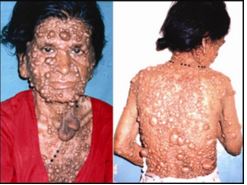
Image 1: Neurofibromatosis
Neurofibromatosis Types
Type 1 or NF1
This type of neurofibromatosis has specific spots on the skin which is medically known as café-au-lait spots, these spots are mainly sited under the armpit or at the back. Other than cutaneous symptom, bones and spine becomes deformed. Infrequently brain tissues and cranial nerves are affected and tumours may develop in these areas. Spinal nerves also have tumour development. This most frequent type of Neurofibromatosis affected individuals has delay in learning symptom. This is identified at early childhood or in adolescent age.
Type 2 or NF2
This type of neurofibromatosis is not usually occurs and reported cases are identified at the early adult age. In this type of neurofibromatosis, cranial and spinal nerves have multiple tumours. One of the common symptoms is loss of hearing as auditory nerve becomes damaged because of tumour formation.

Image 2: Overview of NF2
Neurofibromatosis Causes
Gene mutation malfunctioning causes development of neurofibromatosis.
Cause of NF1
Genetic abnormality when hereditary and transferred from one of the parent who carry abnormal gene causes NF1. Abnormal gene mutation leads to permanent changes in the DNA sequence and resultant uncontrollable cell growth which formed tumour. Chromosome 17 is usually affected which produce neurofibromin, a protein which control the cell proliferation. Alteration of DNA sequences causes insufficiency of neurofibromin and leads to unregulated cell growth.
Cause of NF2
The deficiency of merlin which is another protein synthesized in the chromosome 22 causes development of the NF2. The merlin activity is same as neurofibromin and deficiency is caused due to abnormal mutation of the gene.
Neurofibromatosis Symptoms
Depending upon the types of neurofibromatosis, symptoms vary.
Symptoms associated with NF1
- Café-au-lait spots: In early childhood under the armpit or back side of the neck are having light coloured non elevated harmless spots, more than six in numbers are indicating the presence of NF1 neurofibromatosis.
- Axillary freckles: Under the armpit axillary freckles development is specificity in case of NF1.
- Benign tumour or neurofibromas: Benign tumour or neurofibromas is formed just beneath the skin or on the surface of the skin. This tumour also developed in the nerves. This
- Nodules formed in eye. These nodules are not interfering in vision but helps in diagnosis.
- Physically not usual appearance: Patient with type one neurofibromatosis usually short in height with large sized of the head. Brain volume is higher than the normal.
- Deformed bone: The bone is under developed due to lowering of the calcium label. This can be characterised by bended leg or bow shaped spine.
- Learning disability: Mental development and cognitive impairment causes delayed learning. Psychological symptoms associated with type one neurofibromatosis include attention deficit syndrome or hyperactivity disorder.
- Cardiovascular disorder: Usually with NF1, hypertension is a common symptom.
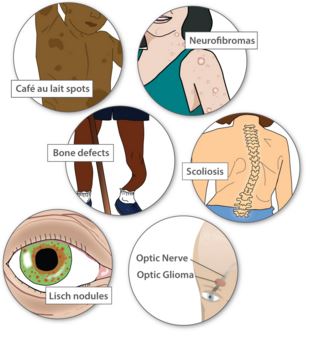
- Image 3: Symptoms of NF1
The symptoms associated with NF2
Vestibular schwannomas
The most common symptom is tumour formation in the auditory nerves which affects vestibule of the both ear and medically termed as vestibular schwannomas. Due to benign tumour formation on the auditory nerve following symptoms are arise, which include:
- Hearing loss
- Balance disturbance
- Ringing sounds produce inside the ear.
Benign tumour formation is not limited in auditory nerve, but it also involves other spinal and cranial nerves, such as optic nerve and also peripheral nerves can be affected and provides following symptoms:
- Lack of sensation in the upper and lower extremities.
- Pain in the face.
- Difficulty in balancing the body.
Neurofibromatosis Treatment
Neurofibromatosis is non curable disease; medical treatment helps to reduce the worsening condition. Early diagnosis, consultation with medical specialisation team for regular monitoring of the symptoms and accordingly treatment plan are the rime factors of the treatment process of the neurofibromatosis. Based on close monitoring of the tumour progression doctors take the decision and plan the treatment.
Surgery
Surgery of the tumour help to control the nerve pressing and related complications like hearing loss, vision disturbance and pain can be controlled. Usually multiple and frequent surgery required, as tumour progression is continuous.
Stereotactic radiosurgery
By applying Stereotactic radiosurgery, vestibular schwannomas can be separated out from the auditory nerve and hearing loss can be prevented, but frequent radiation increase the chances of development of the cancer.
Auditory brainstem implants and cochlear implants.
These implants can improve hearing loss in case of NF2.
Cancer treatment
If the tumour becomes malignant, then chemotherapy and radiation therapy has to be implemented.
Life Expectancy
Life expectancy differs with type and progression of the disease. In case of NF1, if the tumour is non-cancerous then patient usually has normal life expectancy but in case of NF2, the tumour is progressed at the central nervous system which reduces the life expectancy of the patient.
Pictures
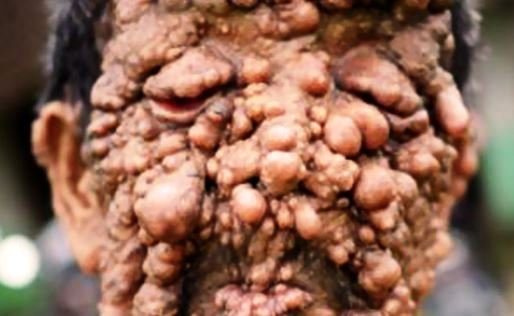
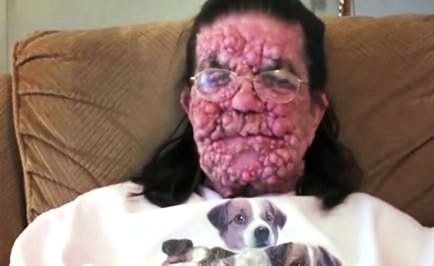
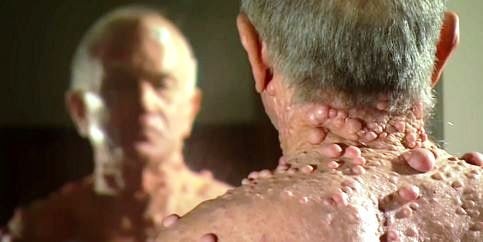

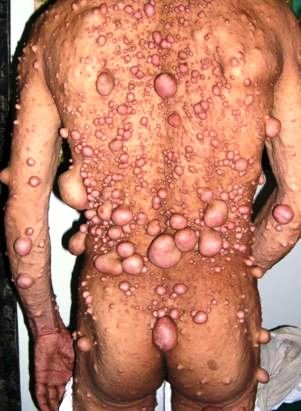
References
- Neurofibromatosis 1 and 2 – Symptoms, Causes, Treatment at http://www.webmd.com/pain-management/neurofibromatosis
- Neurofibromatosis Type 1: Practice Essentials, Background, Pathophysiology at http://emedicine.medscape.com/article/1177266-overview
- http://www.ctf.org/Learn-About-NF/What-Is-NF.html
- http://www.mayoclinic.org/diseases-conditions/neurofibromatosis/basics/definition/con-20027728
- http://www.nhs.uk/Conditions/Neurofibromatosis/Pages/Introduction.aspx
